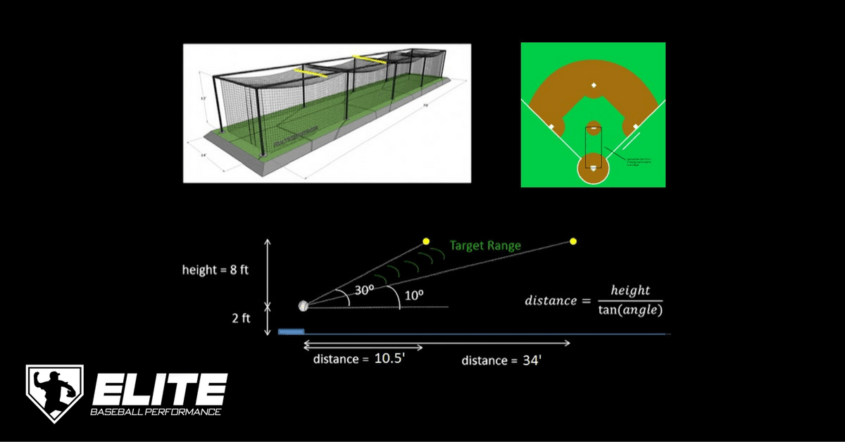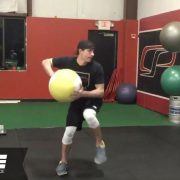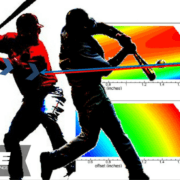Low Tech Ways to Maximize Your Bat Speed and Launch Angle
Data-driven training is becoming the norm in baseball. We have learned so much about things like bat speed and launch angle over the last several years. We know so much more about what goes into becoming an elite baseball player.
But the use of technology can be both daunting and expensive, making the implementation of data-driven training difficult. Luckily, you can bypass the need to spend thousands of dollars on technology and still maximize your hitting potential.
Common Limitations
As the hitting instructor at Prairie Heights High School (IN) for the last four years, I have had the opportunity to implement my own philosophies for the offense under the approval of the ex-head coach Nick Pfafman.
In my first year, Nick had a leash on “new” philosophies. He was hesitant to give too much control to an instructor who was, in his eyes, unproven. However, it did not take him long to loosen that leash. After a short period of time in the program, I was able to open the eyes of the players to the fact that there is much more to this game than they had ever experienced.
Not to discredit what Nick was able to accomplish in his time as the coach before I arrived, he was unable to bring a lot of these newer hitting philosophies to the program.
The reason for that can be attributed to his lack of resources (program money, volunteer coaches, equipment, etc.). He had to turn, what was then, a dying baseball program into something successful. Much to his credit, he did a lot of it on his own.
Upon my arrival, we were able to take the base that he created and build on it. We put a heavy focus on offensive production to complement the already solid defense and pitching staff. Over my first four years, we slowly rolled out newer and better hitting practices in an attempt to build a culture that boasted a high-powered offense.
I want to discuss how we used technology, and even the lack thereof, to help baseball players find more success at the plate.
Setting Up Your Batting Cage
We found that the batting cage was a huge tool for us to run an efficient practice early in the season. We tried to keep our players involved with practice 100% of the time so that we did not have the typical BP session of one guy hitting and the rest of the team shagging balls. Aside from the hitting circuits we conducted to keep everyone working, we used the batting cage as visual to teach players about launch angles.
During last season, I took a job as a 16U coach at Hitter’s Edge in Sturgis, MI. Mike Marks, the owner and head instructor, at Hitter’s Edge had recently equipped his facility with a HitTrax machine. The HitTrax machine measures many different metrics including launch angle, exit velocity, and where the trajectory of any hit ball will land.
At Prairie Heights, with the cage being outside and the HitTrax equipment being extremely costly, we did not see that as a possibility at the time. My major focus, after fundamentals, was getting players to understand the launch angle of a batted ball accompanied with bat speed. When you combine those two things and a good fundamental swing, you will find more success at the plate; especially in the way of extra-base hits.
The challenge was, without a HitTrax machine, how do we measure a player’s launch angle of a batted ball.
Despite everything I ever thought in high school trigonometry class, I needed to use math. I used the equation below to figure out the information I needed.
I wanted to mark the range of where we had to hit the top of the net to achieve the launch angle we wanted.
Our target range was 10° to 30° for our launch angle. We knew our height of the cage was 8’ tall but it needs to be the height of the point of contact to the top of the net. We figured 2’ above the ground was a fair guess. So the height equals 6’ and the first angle is 30° (this will be your closest marker from the plate that you put on your cage).
With this calculation, your first mark needs to be on the top of the cage just shy of 10.5’ away from the plate. The next angle is 10° (this will be your further marker from the plate).
Using the same math, your next marker needs to be 34’ from the plate. I understand that this may be slightly flawed depending on the width of your cage because of where the foul lines are but I think you get the idea here.
Rethinking Batting Practice in a Cage
Allow me to backtrack a little here. When I first met with Mike Marks at Hitter’s Edge, he had a softball player in the cage that he was using HitTrax with during her lesson. He was preaching the idea of lifting the ball. I immediately understand why he was saying this to her. Players at “the next level” can field ground balls just fine so we need to elevate the ball to try to find some “green.”
Line drives and deep, well-hit fly balls are the most difficult hits to defend. The reaction time required to field a hard-hit in the air is much faster than that of a grounder. Batted balls with elevation are obviously not slowed down by the grass and dirt like a ground ball.
I know you are probably thinking “obviously we want line drives and not ground balls” but how often do you hear a coach say “nice hit” when a guy takes him up the middle and the ball hits the back of the cage at belt-height?
I think about how many times in my earlier years of coaching that I would praise a hitter for even hitting a ball six feet off the ground into the side of the net 40’ past the plate. Well, congratulations. That batter probably grounded out. Regardless of how hard that ball is hit, at the high school, collegiate, and professional levels, those balls are going to be fielded.
I decided that it was time was started focusing on hitting the ball over the infielders and, with some added bat speed and exit velocity, over the outfielders.
Think about how big your cage is in comparison to a baseball field.
The average cage I use is 8’ tall and 60’ long. If your hitters are peppering the top back corners of the cage, they’re hitting a ball that is only 8’ off the ground by the time it crosses the mound and it still has approximately 60’ of travel left before it even gets passed 2nd base.
So imagine a 6’ tall pitcher and he can probably reach 7’6” with his extended arm and glove which means that best case scenario you hit a ground ball over his head and if you are lucky to have hit the ball hard enough, you may get it passed the middle infielders resulting in a weak hit to the centerfielder.
I do not want you to think that I think that is a bad result because it is not. If you do that every single time you are at the plate you’ll go down in history with the best batting average of all time.
My focus is not to help our guys hit hard grounders that may or may not result in single. My focus is to create an explosive offense that boasts doubles and bombs from top to bottom of the lineup. When I came to this realization, I knew that I needed to change the way I look at results in the cage.
Adding Power to Your Launch Angle with Weighted Bats
Once I was able to get my students and players to understand the launch angle of their hits, I knew it was time to grow from there. Hitting a ball 30° into the air is not enough if your exit velo is 12mph. We needed to build bat speed to accompany everything else and for those of you that have ever seen/hit with a BBCOR or wood bat, you need a lot of bat speed to park a ball 300’+.
I looked into some of the weighted bat systems and I liked the results that their studies were showing but I did not like the price tags on their bats (refer to my previous statement about lack of resources). Every weighted bat system I found included using a hand-loaded bat, an end-loaded bat, an underloaded bat, and then your own game bat.
I had to try to accomplish this cheaply. Luckily for me, I knew a guy.
I played on an adult amateur baseball team in Fort Wayne, IN with Dr. Daniel Nolan. This guy makes wood bats in his free time out of his wood shop (how cool is that?). His bat-making tools are nothing to laugh about either. Everything he makes is hand turned on a professional lathe and he uses a very precise method to make each bat.
I sent him my design idea for the first one, a hand-loaded bat (see picture). He turned it around in a week and this thing was perfect. The next bat I needed was an end-loaded bat so we brainstormed ideas that might work best. He told me about a billet he had that was very dense and heavy (he used a similar one to make a rolling pin in the past). So within a week, he turned another bat for me.
The biggest question was how we were going to add weight specifically in the end of the barrel. Dan had the idea of milling out the end of the bat and adding weight to it so that we did not change the shape of the barrel in any way. So there were my two loaded bats and I had a nice ash bat that was a -5 already which worked as the underloaded bat.
Immediately, I put my new system to work. Using myself and other fellow players as my lab rats for the system, we found success that translated to an increase of 5-10 miles per hour within the six week program.
Based on a study that I found, every 5 mph added to your exit velocity equals approximately 25’ distance on a batted ball hit at a 30° launch angle. When you are talking about adding a potential of 50’ to your hits in 6 weeks, I will buy into that process.
Using Baseball Swing Tracking Apps
Even though we bypassed using the HitTrax machine, we did find other cost-effective tools to evaluate players. The most important tool we used at PHHS, one that we used since day one of my arrival, was an app called Coach’s Eye. I’m sure many of you are already using this app but I cannot get enough of the simplicity of this app.
The other tool we have started using in the past year is the Blast Motion Sensor. This little sensor goes right on the butt of your bat and records many useful metrics. We record the average of everyone’s metrics from each session so that we can show progress over time.
[Editor Note: There are several devices on the market, including Diamond Kinetics and Zepp]
These tools really help all of our players to visualize their swing and their progress. It does not always help the younger kids but it helps their dads so that they can help their son in between sessions.
Putting it All Together
100% of the time I will tell you that fundamentals are king.
Without sound fundamentals, your bat speed, exit velocity, and launch angle are irrelevant because you will not be able to replicate it consistently enough to be considered a good hitter. Whether you teach linear or rotational hitting, you have to be able replicate success consistently before you can get more advanced. I teach rotational hitting to every single one of my students and players. Without sparking an argument with anti-rotational hitting advocated, I just believe that it gives players the best opportunity to make consistent contact in the zone.
Once a player has a good fundamental swing, that is when it is time to start training for bat speed. I do believe that you can discuss launch angles with hitters during the fundamental teaching phase of their training. If you are using a cage to teach fundamentals, then using the launch angle markers in the cage can really help you and your hitters to understand and visualize the goal.
Teaching players to get on plane, increasing their bat speed, and getting their launch angles to the ideal range is the best way to get rewarding results all season long; however, I know that so many people will argue that players still need to put the ball on the ground in hit and run situations and with runner-on-third situations.
I would say that if a player hits a screaming line drive on a hit and run, regardless if he lines out and gets the runner doubled off, then can you really be upset with the hitter. As a coach, the hit and run is always a risky play. I would rather see a hitter hitting a ball hard on a line or with a little elevation than changing their swing altogether for a ground ball. No one ever said you couldn’t hit a double or a homer on a hit and run or with a guy on third base. Change your mental approach at the play, not your swing.
It is time, we as coaches, progress in our offensive policies.
There is room for plenty of old school philosophies in baseball but it is time we quit teaching “swing level” and “put the ball on the ground and make them throw you out”. Players do not get scouted and drafted based on their ability to ground out and move runners the hard way; they get to “the next level” by showing that they can hit for, not only average, but also for power.
It’s a new game we play and you know the old adage: “the best defense is a good offense.”
TJ Guthrie
Latest posts by TJ Guthrie (see all)
- Low Tech Ways to Maximize Your Bat Speed and Launch Angle - October 31, 2017












Trackbacks & Pingbacks
[…] “There is room for plenty of old school philosophies in baseball, but it is time we quit teaching “swing level” and “put the ball on the ground and make them throw you out.” Players do not get scouted and drafted based on their ability to ground out and move runners the hard way; they get to “the next level” by showing that they can hit for, not only average but also for power.” (Guthrie, 2019) […]
[…] “There is room for plenty of old school philosophies in baseball, but it is time we quit teaching “swing level” and “put the ball on the ground and make them throw you out.” Players do not get scouted and drafted based on their ability to ground out and move runners the hard way; they get to “the next level” by showing that they can hit for, not only average but also for power.” (Guthrie, 2019) […]
Leave a Reply
Want to join the discussion?Feel free to contribute!